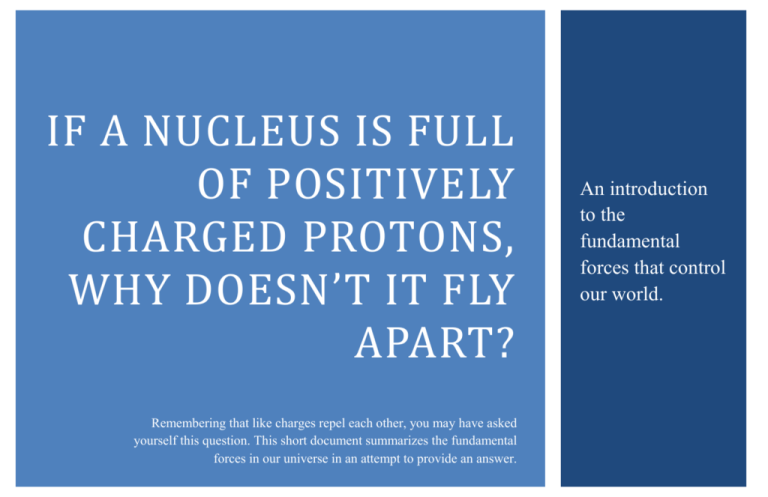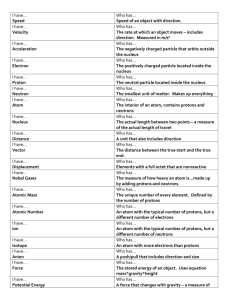Why does a nucleus that is full of positively
advertisement

IF A NUCLEUS IS FULL OF POSITIVELY CHARGED PROTONS, WHY DOESN’T IT FLY APART? Remembering that like charges repel each other, you may have asked yourself this question. This short document summarizes the fundamental forces in our universe in an attempt to provide an answer. An introduction to the fundamental forces that control our world. Why does a nucleus that is full of positively charged particles not fly apart? What attracts or repels things? Any interaction between two objects that pushes or pulls on them is called a force. As we have studied pushes and pulls, it became clear that it takes two objects to create a force: Can you think of a force that does not involve two objects? Probably not. If you think of an example, think deeper and you’ll see that there is always “something” pushing or pulling on “something else.” Electromagnetic interactions You probably know the old saying “Opposites attract.” It’s often used when you see a couple that seem so different but are so much in love. While in humans, this is not always true, with electrical charges it is always true. The force of attraction between a proton (has a positive charge) and an electron (has a negative charge) is called the electromagnetic force. The root of the word “electric” is the Greek and Latin words for amber (if you’ve seen the movie Jurassic Park, you may remember the mosquito caught in amber). Amber can easily gain a static electric charge, and people for millennia have related amber with static electricity. As we learned more about this “amber” quality, we called this force electric, and the objects that could produce it electrons. Electricity is the movement of electrons. But what’s up with the “magnetic” part of electromagnetic??? You may have seen an electromagnet at some point. The discovery of electromagnets exposed a connection between magnetic forces and electrical forces. The image of the doorbell on the right shows an electromagnet. When someone pushes the button at the door, electricity runs through the two coils and creates a magnetic force that pulls the metal clapper towards them – “Ding!” As we learned more, we discovered that all magnetism is cause by movement of charged particles (usually electrons). A bar or ring magnet is magnetic due to the movement of electrons within the metal atoms. In most elements, the motion of electrons cancel out these magnetic forces, and the object doesn’t act as a magnet. But a few elements have electron configurations that allow those metals to become permanent magnets (iron, nickel, cobalt, and a few other mixtures of metals). Thus, we now call all forces that are caused by the charge of an object the electromagnetic force. These forces can be attractive (opposites: + & — or North & South) or repulsive (+ & + or — & — or North & North or South & South). Electromagnetic forces are what hold molecules together, and generally control the day-to-day chemical interactions in our lives. Gravitational interactions Another force that we are used to is the force of gravity. We see things fall every day because gravity is pulling down on them. We feel this force of gravity when we try to hold a heavy object up—the earth’s pull on that object is just as real as if a friend were pulling on it. But what causes gravity??? People have noticed for millennia a connection between the position of the moon and the tides. As people studied more and more, it became evident that the tides were not just caused by the moon, but also by the sun. Both of these objects “reach out” through space to pull on the water on our earth, making the water bulge that appears to move around the earth (actually, the bulge stays in about the same place, it’s the earth that is spinning under it). When astronauts landed on the moon, they dropped objects to confirm, for all to see, that the moon pulls on objects just like the earth (only not as strongly). HARBOR AT GOREY , J ERSEY , AT LOW TIDE So, the earth has gravity, the moon has gravity, the sun has gravity. Landing rovers on Mars “proved” that there is gravity on Mars—if there were no gravity on Mars, when one of the rovers hit a bump, it would float off into space. Scientists wondered if there was a limit on the size of an object that would produce a force of gravity: If the sun, earth, Mars, and Moon all have gravity, would there be a “smallest” object that would be able to produce a gravitational force? After careful experimenting, scientists have been able to measure gravitational forces between objects small enough to hold in your hand. The Newtonian model1 of gravity states that any object with mass can exert a gravitational attraction on any other object with mass. While the electromagnetic force controls our chemical reactions, it is too weak at long distances, and thus gravity controls the movement of stars, planets, and “human scale” objects on earth. Isaac Newton’s description of gravity is a good model, but is not complete. Einstein’s model of general relativity, published in 1916, provides a more robust description of gravity, but does not disagree with the day-to-day force of gravity as described by Newton. 1 And finally, an answer to our initial question: “Why does a nucleus that is full of positively charged objects not fly apart?” Since protons repel protons, scientist first modeled the nucleus as one positive object. If you take away some electrons, the charge of the atom (now an ion) is positive. Add some extra electrons and the charge is now negative. But eventually we learned that the nucleus has smaller particles with positive charges—and this leads to the question “What is keeping them together?” With the development of a model of a new force, a nuclear force, the question was answered. Unlike the gravitational and electromagnetic forces, the nuclear force had not been seen because our human-scale objects do not experience this force. But scientists knew it had to be there. As they researched more, it was discovered that there are actually two nuclear forces, and they were given the names “strong nuclear” and “weak nuclear” (not very original, huh?). The main one that holds the nucleus together is the strong nuclear force, so we’ll ignore the weak nuclear force for this discussion. The strong nuclear force is an attractive force between both protons and neutrons, in any combination. Thus protons are attracted to protons, neutrons to neutrons, and protons to neutrons. And, just like our understanding of magnetism lead to the connection between it and electricity, we now know of particles smaller than protons and neutrons, and are discovering their roles in the nuclear forces. But that’s a story for another day Comparison of fundamental forces Force Relative strength Most evident in what distances? Gravitation Weak Human scale to solar systems to galaxies Electromagnetic Medium Atoms, ions and molecules to human scale Weak nuclear Strong Closer than the diameter of a proton Strong nuclear Strongest Closer than 1/1,000th the diameter of a proton Text by Lee Trampleasure, Carondelet High School, 2014. lee@trampleasure.net trampleasure.net/lee Permission to distribute and use is hereby given under ShareAlike 4.0 International All images are sourced from Wikipedia with permission granted for reuse, except Mars Spirit Rover, which is public access from NASA http://marsrover.nasa.gov/gallery/press/spirit/20121109a.html








